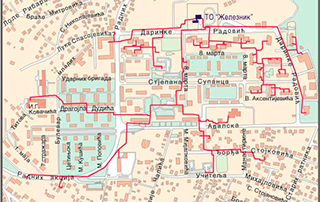The Guidelines of the task 2.6 will focus on energy planning and economy, Network topology, Scenarios for timeline and energy sources, necessary measures for implementation, project developments and operation and management.
DOWNLOAD THE DOCUMENT HERE (PDF) >>

One smaller generation plant with main network and subnetwork in Belgrade district heating network.
In RELaTED Task 2.6 a set of guidelines were developed for how the low temperature concepts can be applied for operational high temperature district heating networks. This report (D2.6) is one of various RELaTED reports describing low temperature concepts from different perspectives. The report refers to other RELaTED reports when relevant.
The guidelines of this report are in general terms, based on best practice as most DH networks are different in relation to visions, DH network topology, temperature levels, building installations, tariff structure, management etc. In Annex 1 an example from Belgrade is used to illustrate and detail some of the paragraphs of the report.
The guidelines are concerning the following topics:
- Strategic and integrated energy planning covers the vision for the transition process and the strategy of how to implement it. It also covers the integration in the existing system.
- For the DH supplier the economy focus is on investments, operation expenses and how this compares to the possible income from heat sales. From the customers point of view the focus might be related to the total energy cost and how it affects the customers economy after the transition compared to before.
- Different types of temperature reduction measures at network sectioning’s are described based on a centralized DH network topology.
- The scenarios for how the transition will roll out over a longer period of time including change in energy demand and potential new energy resources are studied. Pros and cons regarding temperature levels of the network in transition and how it affects the changes of building installations and heat loss in the network are discussed.
- The implementing measures involves how the delivery conditions as well as the technical building systems specifications are defined and how building renovation regulation can influence on this process.
- Operation and management cover how the operation and the management of the system is handled in the transition process and afterwards.
- The guidelines will be used in the succeeding work packages of RELaTED to investigate further the architecture of the ULT concept (WP2), design and adaption of subsystems to facilitate the use of distributed energy resources (WP3), analyse the economic feasibility and business case (WP4) and prepare and conduct demonstrations (WP5), of the RELaTED project.
